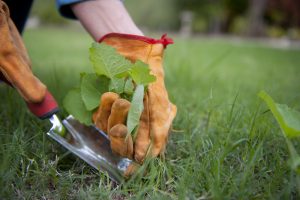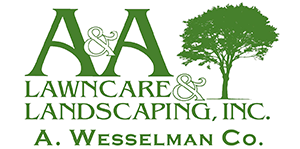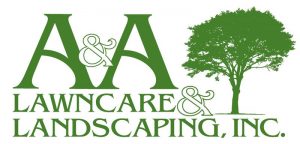 Weeds are plants defined, not necessarily by their own intrinsic characteristics, but primarily by their relationship with humans. Gardeners themselves define weeds as those plants that interfere with their plans and compete with their preferred plants for light, water, and nutrients. Weeds are plants that grow where they are not wanted. This undesirable flora tends to be invasive and difficult to eradicate, so while it’s a pain to see them in a flower bed, it is particularly challenging to find them in your yard. Stressed lawn is more susceptible to weeds than a well-maintained lawn. Here’s what to do to help your lawn choke out weeds when they try to grow…
Weeds are plants defined, not necessarily by their own intrinsic characteristics, but primarily by their relationship with humans. Gardeners themselves define weeds as those plants that interfere with their plans and compete with their preferred plants for light, water, and nutrients. Weeds are plants that grow where they are not wanted. This undesirable flora tends to be invasive and difficult to eradicate, so while it’s a pain to see them in a flower bed, it is particularly challenging to find them in your yard. Stressed lawn is more susceptible to weeds than a well-maintained lawn. Here’s what to do to help your lawn choke out weeds when they try to grow…
Water Properly
Supplement natural rainfall by irrigating your lawn as needed. Proper watering provides an average lawn with the equivalent of about 1 inch of rainfall each week. This allows moisture to penetrate deeply and encourages healthy, deep root growth. Watering only once or twice per week is better than more frequent watering. nourish your lawn with a deep watering to promote the establishment of healthy root systems. An infrequent (once or twice per week) deep watering is just what the lawn doctor ordered.
Mow High
Mow based on grass growth, not your calendar. Time your mowing so you remove roughly one-third of the length of the grass blades in a single mowing. Mowing low allows weeds more access to sunlight, air, and nutrients. Set your lawn mower to a higher setting to keep grass growing high. This keeps weeds in the shade and prevents them from growing.
Feed Your Lawn
Feeding your lawn on a regular basis (most experts suggest every 6 to 8 weeks) with lawn food helps it grow thicker and fill in patches, making your lawn a less-hospitable home to weeds. Keep your lawn well-fed with quality weed & feed or fertilizer-only products. Always consult the product label for your specific lawn grass type before using any type of weed control products.
Herbicides
Selective herbicides can be further divided into pre-emergent and post-emergent herbicides.
Pre-emergent herbicides are applied to the soil, and they kill young seedlings soon after they emerge.
Post-emergent herbicides are usually applied to the foliage where they are absorbed into the plant tissue.
There are times when the only way to get rid of a stubborn weed is to treat it with an herbicide. Don’t be afraid to use herbicides if you need them, but try other control methods first. Pulling, hoeing, tilling and digging will often take care of weed problems without the need for chemical sprays
Hand Pulling
While hand pulling is the simplest method, it’s only effective against smaller weeds with shorter roots. It also assumes that you’re able to spend extended periods of time on your knees, reaching for and pulling weeds. For anything else, you’ll need a weeding tool of some kind. There are two basic styles of weeding tools – short handled and long handled. Short-handled tools are best for working on your knees in tight or closely planted areas. Long-handled tools allow you to stand while weeding and cover a larger area. Hand pulling is, quite literally, a pain. If you have a small plot of grass, however, it might be your quickest, most efficient option for weed removal. Hand pulling involves removing weeds from the soil by their root, hindering their ability to grow back.
Our Lawn Care Program Has You Covered!
A & A Lawn Care provides a 6 application program to control and prevent weeds from appearing in your lawn.
- Early Spring – This early Spring application includes a fertilizer and pre-emergent herbicide. The fertilizer will promote early Spring green up and add proper nutritional value for the lawn while it is coming out of from winter dormancy. In addition, a pre-emergent herbicide was applied
to protect your lawn from crabgrass and grassy weeds. - Late Spring/Early Summer – The late Spring application will provide a Spring fertilizer with bio-nutrients, a post emergent herbicide for broadleaf weed control. This will promote a healthy lawn, an additional pre-emergent herbicide will help to control any crabgrass and weeds that may still come up and control broadleaf weeds.
- Early Summer – The early Summer application provides a balanced slow release Summer fertilizer that will help maintain the color of your lawn without pushing growth. This application also contains broadleaf weed control and a safe insect control to protect from surface feeding insects.
- Late Summer – The late Summer application contains a Nature Safe organic fertilizer to work organic matter into your soil where it needs it most. This application also provides broadleaf weed control on an as needed basis.
- Early Fall – This early Fall fertilizer will help green up the grass and help the lawn to recover from any Summer stress. Also, broadleaf weeds that are present will be controlled.
- Late Fall/Winter – This Winter application will thicken your lawn and also encourage new root development.
Contact Us (859-384-0266) for a Free Consultation!
—
 About A & A Lawn Care & Landscaping
About A & A Lawn Care & Landscaping
A & A Lawn Care & Landscaping can beautify your lawn and landscaping using our vast experience in turf grass management. Our complete lawn service is designed for both residential and commercial lawns and we keep your lawn healthy without harming your family, staff, or pets.

 About A & A Lawn Care & Landscaping
About A & A Lawn Care & Landscaping